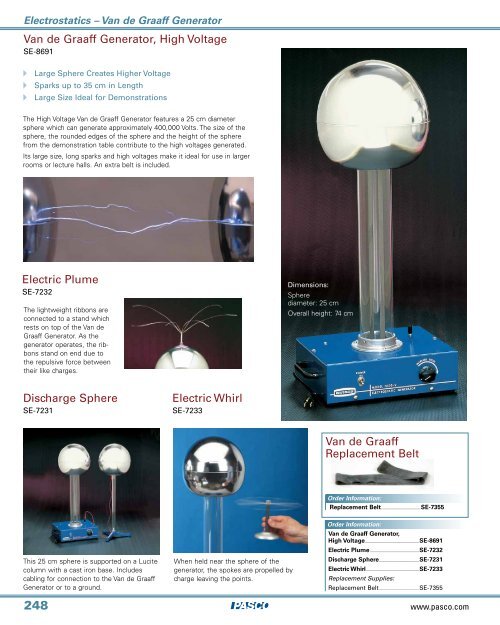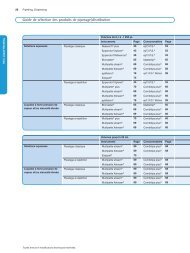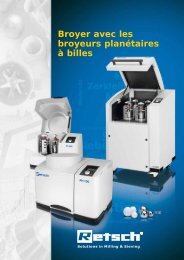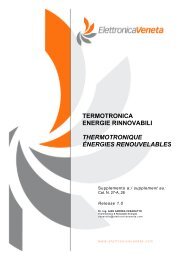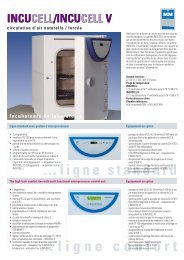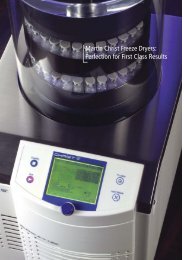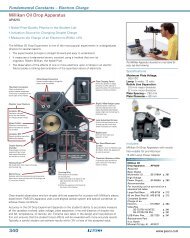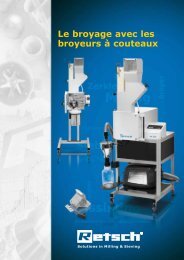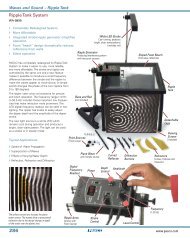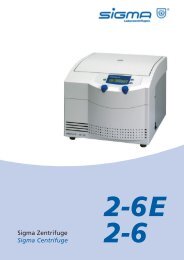Van de Graaff Generator, High Voltage Discharge Sphere Electric ...
Van de Graaff Generator, High Voltage Discharge Sphere Electric ...
Van de Graaff Generator, High Voltage Discharge Sphere Electric ...
You also want an ePaper? Increase the reach of your titles
YUMPU automatically turns print PDFs into web optimized ePapers that Google loves.
Electrostatics – <strong>Van</strong> <strong>de</strong> <strong>Graaff</strong> <strong>Generator</strong><strong>Van</strong> <strong>de</strong> <strong>Graaff</strong> <strong>Generator</strong>, <strong>High</strong> <strong>Voltage</strong>SE-8691A Large <strong>Sphere</strong> Creates <strong>High</strong>er <strong>Voltage</strong>A Sparks up to 35 cm in LengthA Large Size I<strong>de</strong>al for DemonstrationsThe <strong>High</strong> <strong>Voltage</strong> <strong>Van</strong> <strong>de</strong> <strong>Graaff</strong> <strong>Generator</strong> features a 25 cm diametersphere which can generate approximately 400,000 Volts. The size of thesphere, the roun<strong>de</strong>d edges of the sphere and the height of the spherefrom the <strong>de</strong>monstration table contribute to the high voltages generated.Its large size, long sparks and high voltages make it i<strong>de</strong>al for use in largerrooms or lecture halls. An extra belt is inclu<strong>de</strong>d.<strong>Electric</strong> PlumeSE-7232The lightweight ribbons areconnected to a stand whichrests on top of the <strong>Van</strong> <strong>de</strong><strong>Graaff</strong> <strong>Generator</strong>. As thegenerator operates, the ribbonsstand on end due tothe repulsive force betweentheir like charges.Dimensions:<strong>Sphere</strong>diameter: 25 cmOverall height: 74 cm<strong>Discharge</strong> <strong>Sphere</strong>SE-7231<strong>Electric</strong> WhirlSE-7233<strong>Van</strong> <strong>de</strong> <strong>Graaff</strong>Replacement BeltOr<strong>de</strong>r Information:Replacement Belt.........................................SE-7355This 25 cm sphere is supported on a Lucitecolumn with a cast iron base. Inclu<strong>de</strong>scabling for connection to the <strong>Van</strong> <strong>de</strong> <strong>Graaff</strong><strong>Generator</strong> or to a ground.248When held near the sphere of thegenerator, the spokes are propelled bycharge leaving the points.Or<strong>de</strong>r Information:<strong>Van</strong> <strong>de</strong> <strong>Graaff</strong> <strong>Generator</strong>,<strong>High</strong> <strong>Voltage</strong>........................................................SE-8691<strong>Electric</strong> Plume....................................................SE-7232<strong>Discharge</strong> <strong>Sphere</strong>..........................................SE-7231<strong>Electric</strong> Whirl.......................................................SE-7233Replacement Supplies:Replacement Belt..........................................SE-7355www.pasco.com
Electrostatics – ChargeClassic ElectrostaticsMaterials KitSF-9068Providing the classic introduction toelectrostatics, this kit allows stu<strong>de</strong>nts torub any of the three rods with rubbing clothsto produce a positive or negative charge.Place the rods on the insulated pivot standsto investigate electrostatic forces.Inclu<strong>de</strong>s:Three rods (acrylic, glass, PVC)Two insulated pivot standsThree rubbing cloths (wool, silk, fur)Discover Charge SetES-8086A Explore the Bipolar Nature of ChargeA Experimentally Rank Materials within the Triboelectric SeriesThe Discover Charge Set provi<strong>de</strong>s stu<strong>de</strong>nts with a collection of materials to explorethe nature of static charge. By rubbing two sheets of material together, electrons aretransferred from one material to the other. Stu<strong>de</strong>nts then hold each of the chargedmaterials near a charged indicator to discover the direction of charge flow. Using thisinformation, the materials can be ranked within the triboelectric series by rubbing witheach of the materials in the set.Negatively charged tape is usedas an indicator to verify thematerial’s charge.Or<strong>de</strong>r Information:Classic ElectrostaticsMaterials Kit......................................................SF-9068ElectroscopeSF-9069When this Electroscope is charged, theconductive rod rotates to indicate chargemagnitu<strong>de</strong>. The shield ring is 15 cm indiameter and can be groun<strong>de</strong>d with bananaplug connectors (not inclu<strong>de</strong>d).Inclu<strong>de</strong>s:Charge Sampler: For transferring charge tothe ElectroscopeCapacitor Plates (5.6 cm dia.): For testingcharges without <strong>de</strong>positing them on theElectroscopeRub two sheets together to transfercharge from one sheet to the other.Or<strong>de</strong>r Information:Or<strong>de</strong>r Information:Inclu<strong>de</strong>d Materials:TeflonStyrenePolyesterWoolPVCEach material sheet measures15 cm x 10 cm.Electroscope......................................................SF-9069Discover Charge Set..............................................................................................................................................ES-8086249
Electrostatics – Electrostatics SystemsBasic Electrostatics SystemES-9080AA Quantitative ElectrostaticsA Comprehensive ExperimentManual Inclu<strong>de</strong>dA Individual or Demonstration UseThe PASCO BasicElectrostatics Systeminclu<strong>de</strong>s all thecomponents necessaryfor a quantitativeinvestigation into thebasics of electrostatics.With this integrated setof equipment, stu<strong>de</strong>ntscan study:A Production of charges,equal and oppositeA Charge by inductionA Principle of the Faraday Ice PailA Charge transferA Charge distribution in electric fieldsA Capacitors and the Q=CV relationshipA Moving charges and currentOr<strong>de</strong>r Information:Basic Electrostatics Systems...........................................ES-9080ARecommen<strong>de</strong>d:Charge, Equipotential and Field Mapper..........ES-9060 p. 252Inclu<strong>de</strong>s:ES-9078 Basic ElectrometerES-9057C Charge Producers andProof PlaneES-9042A Faraday Ice Pail and ShieldES-9059C Conductive <strong>Sphere</strong>s, 13 cmES-9061 Conductive ShapesES-9079 Basic Variable CapacitorES-9077 Electrostatics <strong>Voltage</strong>SourceExperiment ManualBasic ElectrometerES-9078The PASCO Basic Electrometer is a quantitativeelectroscope, measuring the polarity andmagnitu<strong>de</strong> of charged objects. With almostinfinite input resistance (10 14 ohm), theElectrometer is a high impedancevoltmeter, draining almost no chargefrom the object it is measuring.Direct Polarity IndicationCentered zero scale shows bothpositive and negative charges.Signal OutputTo computer interface.Range IndicatorLEDsRange AdjustmentSwitchAdjust the sensitivity tomatch the experiment.250On/Off SwitchQuantitative ReadoutReadout in volts can be calibratedfor units of charge.Connector forShiel<strong>de</strong>d InputCableGrounding JackZero ButtonFeaturesCenter-Zero Meter. Polarity is indicateddirectly.3, 10, 30 and 100 VDC Switch-SelectableRanges. LED lamps indicate the range in use.Zeroing Switch. For removing all charge fromthe input and bringing the meter to zero.Automatic Shutoff. Unit turns off aboutthree hours after being used.Output Compatible with ScienceWorkshopInterfaces. For recording data or producing a<strong>de</strong>monstration-sized meter display.Battery Operation. Uses four “AA” cells(inclu<strong>de</strong>d). Range indicator lights flashwhen batteries need to be replaced.Inclu<strong>de</strong>d Cables. Shiel<strong>de</strong>d input cable forconnecting the Electrometer to the FaradayIce Pail or other source of charge; groundingcable with clip; ScienceWorkshop interfacecable.Instruction and Experiment Manual.Or<strong>de</strong>r Information:Basic Electrometer....................................ES-9078www.pasco.com
Charge Producers andProof PlaneES-9057CThe ChargeProducers createequal positive andnegative chargeswhen rubbedtogether. The ProofPlane samples theUse the ball endto sampleinsi<strong>de</strong> thehollowsphere.charge <strong>de</strong>nsity from a charged object. Thecharge can then be measured using theElectrometer and Faraday Ice Pail.Conductive <strong>Sphere</strong>sES-9059C30 cmhighElectrostatics – Electrostatics SystemsConductive ShapesES-906130 cmhighOr<strong>de</strong>r Information:Charge Producers andProof Plane......................................................ES-9057CElectrostatics<strong>Voltage</strong>SourceES-9077This compact unit is i<strong>de</strong>al for performingexperiments in electrostatics. It may beused as a source of charge or to maintainan object at a constant potential. Sincethe current required for such applicationsis small (on the or<strong>de</strong>r of nanoamps), highmegohm resistors (120 MΩ per kV) areplaced in series with each output.Output voltages are 1000, 2000 and3000 VDC, allowing stu<strong>de</strong>nts to makequantitative investigations of how voltageaffects charge <strong>de</strong>nsity on spheres, capacitorplates, etc. A 30 VDC source is alsoprovi<strong>de</strong>d for experiments with capacitors.Banana plug to spa<strong>de</strong> lug connecting cablesare inclu<strong>de</strong>d.SpecificationsOutput: 30, 1000, 2000, 3000 VDC ±3%,line regulatedResistance in Series with Output:120 MΩ/kVOperating <strong>Voltage</strong>: 115/220, 50/60 HzAC Adapter: 9 VDCOr<strong>de</strong>r Information:Electrostatics <strong>Voltage</strong>Source...................................................................ES-9077These Conductive <strong>Sphere</strong>s (two per set)can be used to store charge or investigatethe charge distribution on one or twospherical conductors. A terminal on thebottom of each sphere provi<strong>de</strong>s a connection point for the power supply. Eachsphere is attached to a heavy base (forstability) with an insulating rod. The spheresare 13 cm in diameter and 30 cm high.Or<strong>de</strong>r Information:Conductive <strong>Sphere</strong>s............................ES-9059CBasic Variable CapacitorES-9079This variable, parallel plate capacitor permitsa quantitative investigation of the Q=CVrelationship. Two 18 cm diameter platesallow the capacitance to be varied from225 pF to zero by sliding the movable platein its 28 cm long track. The sliding platehas adjustment screws to make the platesparallel to each other. <strong>Electric</strong>al connectionstuds are located on each plate.A BNC connector cable is provi<strong>de</strong>d forconnection to an Electrometer.Or<strong>de</strong>r Information:Basic VariableCapacitor............................................................ES-9079This set inclu<strong>de</strong>s a conductive sphere witha hole in it: Demonstrate that static chargeresi<strong>de</strong>s the outsi<strong>de</strong> surface of a conductivesphere by sampling the insi<strong>de</strong> surface withthe ball end of the proof plane (ES-9057C,shown at left).Also inclu<strong>de</strong>d is an oblong shape for<strong>de</strong>monstrating the difference in charge<strong>de</strong>nsities on a large-radius surface versus asmall-radius surface. The whole surface isat the same potential and stu<strong>de</strong>nts seemsurprised to find that the charge <strong>de</strong>nsity isgreater on the smaller end.Or<strong>de</strong>r Information:Conductive Shapes..............................ES-9061Faraday Ice Pailand ShieldES-9042AWith the Faraday Ice Pail, stu<strong>de</strong>nts can usethe Electrometer to measure charge as wellas potential. Touch the Proof Plane to thepoint of interest on the charged body, thenplace the Proof Plane insi<strong>de</strong> the ice pail.The Electrometer reading will be directlyproportional to the charge on the ProofPlane.The Faraday Ice Pail is 10 cm in diameterand 15 cm <strong>de</strong>ep. It is ma<strong>de</strong> of wire mesh,so it is easy to see what is going on insi<strong>de</strong>.The outsi<strong>de</strong> shield has a diameter of 15 cm.Or<strong>de</strong>r Information:Faraday Ice Pail..........................................ES-9042A251
Electrostatics – Charge/Field MappingCharge, Equipotentialand Field MapperES-9060Field Mapper KitPK-9023Conductive PaperPrinted grid makesmeasurements easy.Cork SurfaceUse pushpins to hold the paper duringthe experiment.The Charge, Equipotential and FieldMapper is an excellent addition to theBasic Electrostatics System.Draw any set of two-dimensionalconductors with the conductive ink.Investigate the electric field and theequipotential field lines between andaround the conductive paper to any shape.Charge it and investigate the distribution ofcharge on its surface.Similar to the PK-9023 Field Mapper Kit,except it inclu<strong>de</strong>s elec trom e ter probes, a“point charge” hol<strong>de</strong>r and larger sheets ofcon duc tive paper for in ves ti gat ing chargedis tri bu tions on con duc tive surfaces.Inclu<strong>de</strong>s:Conductive paper for mapping chargedistributions; 30 x 45 cm (50 sheets)Conductive paper with cm grid for mappingequipotentials and field gradients;23 x 30 cm (100 sheets)Pushpins (10), connecting wire (1)an<strong>de</strong>lectrometer probes (2)Conductive ink pen and a circular templatefor drawing conductors“Point charge” hol<strong>de</strong>rPlastic tray with corkboard top;32 x 48 cmManual with 13 experimentsOr<strong>de</strong>r Information:Charge, Equipotentialand Field Mapper....................................ES-9060Replacement Supplies:Conductive Ink Pen...............................PK-9031B(limited shelf life of six months;pen is not refillable)Conductive Paper with grid(50 sheets, 23 x 30 cm)....................PK-9025Conductive Paper (no grid)(100 sheets, 30 x 43 cm)................PK-9026252Storage TrayAfter the lab, everything storesneatly un<strong>de</strong>r the corkboard.How it WorksWith this kit stu<strong>de</strong>nts can map both thepotentials and the electric fields around anyconceivable system of two-dimensionalcharged conductors.The procedure is simple:1. Draw any Electro<strong>de</strong>: Draw the electro<strong>de</strong>with the special, conductive silver ink pen.It is easy to use, dries quickly and there isno mess.2. Plot the Equipotentials: Connect a batteryor power supply across the electro<strong>de</strong>s,then use a voltmeter to locate the equi potential lines.3. Plot the <strong>Electric</strong> Field: Tape voltmeterprobes together, then hold one probeon the paper and rotate the other probearound it like a compass. The maximumvoltage reading indicates the direction ofthe electric field.Inclu<strong>de</strong>s:Conductive paper with cm grid;23 x 30 cm (50 sheets)10 pushpins; three wiresConductive ink pen and circular templatePlastic tray with corkboard top;32 x 48 cmInstruction manual with 10 experimentsSpecial ConductiveInk PenThe PASCO Con duc tive Silver Ink Pen makesit easy to study field patterns. Draw over 60meters of patterns with a single pen. Penshelf life is six months. Not refillable.Or<strong>de</strong>r Information:Conductive Ink Pen..............................PK-9031BConductive PenDraw any shaped charge electro<strong>de</strong> withthis conductive ink pen.Or<strong>de</strong>r Information:TypicalExperiments1. Dipoles of Like Charges2. Dipoles of Opposite Charges3. Parallel Plate Capacitor4. Point Source and Guard Ring(cylindrical capacitor)5. Floating Electro<strong>de</strong>Plus five more experiments.Check out the experimentsat www.pasco.comField Mapper Kit...............PK-9023Required:Basic DigitalMultimeter................................SE-9786A p. 281(or any voltmeter with atleast a 10 M Ω input impedance)Power Supply.......................SE-8587 p. 279(or another low voltageDC power supply or battery)Replacement Supplies:Conductive Ink Pen.........................PK-9031B(limited shelf life of 6 months;not refillable)Conductive Paper with grid(50 sheets, 23 x 30 cm)..............PK-9025Conductive Paper (no grid)(100 sheets, 30 x 43 cm)..........PK-9026www.pasco.com
Electrostatics – CircuitsCharge/<strong>Discharge</strong> CircuitEM-8678The Charge/<strong>Discharge</strong> Circuit offers a unique way to observe and measure the behaviorof DC circuits including batteries, capacitors, light bulbs and resistors. It also inclu<strong>de</strong>s anopen slot to allow a component of choice to be inserted for further experimentation.Experiment ExampleCharge the capacitor using batteries,then discharge through a resistor or lightbulb. Stu<strong>de</strong>nts measure the voltage andcurrent as the capacitor discharges, andcan graph the relationship between voltageand current for various components.See complete experiment on page 384.RelayCI-6462A Single-Pole Double-Throw SwitchA Activated by DataStudio orXplorer GLXA For Sense and Control Projects<strong>Voltage</strong> vs. Current for a 33 Ω resistor, a10 Ω resistor, and a light bulb. Note thenon-linearity for the bulb.ResistorsLight Bulbs1F CapacitorBatteries (notinclu<strong>de</strong>d)This relay is a single-pole double-throwswitch that is controlled by DataStudioor the Xplorer GLX for Sense and Controlexperiments. It is shown here with theEM-8678 Charge/<strong>Discharge</strong> Circuit, automaticallyturning on the light whenever thetemperature above the bulb reads lessthan 25 °C.Charge/<strong>Discharge</strong> SwitchUse your own rechargeable batteriesto investigate the efficiency of energystorage and recovery.The area un<strong>de</strong>r the power versus time graph isenergy. 99 J of energy is <strong>de</strong>livered to the battery.During discharge, 51 J (52%) is <strong>de</strong>livered to the bulb.Inclu<strong>de</strong>s:1 Farad Capacitor#14 Light Bulbs (3)10 Ω Resistor33 Ω Resistor100 Ω ResistorOr<strong>de</strong>r Information:Battery Hol<strong>de</strong>rs(uses AA or AAA)Double Throw KnifeSwitchInstruction ManualThe Relay is controlled through theXplorer GLX calculator:The statement above means that the Relay is switchedon and the light comes on when the temperature probein port #1 of temperature sensor #1 readsbelow 25 °C.Or<strong>de</strong>r Information:Charge/<strong>Discharge</strong> Circuit..........................................................EM-8678Recommen<strong>de</strong>d:#14 Light Bulbs (25 pack)..........................................................EM-8627 p. 260Batteries AA (4 pack)......................................................................PI-6601 p. 261Relay..........................................................................CI-6462Required:Digital Adapter.............................................PS-2159PASPORT Interface..................................p. 6-23253


